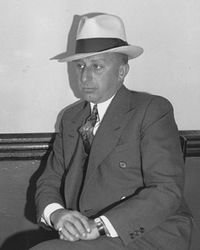09.19
This week (September 19-25) in crime history – The Washington Post published the Unabomber’s manifesto (September 19, 1995); President James Garfield died from gunshot wound (September 19, 1881); Benedict Arnold committed treason (September 21, 1780); The Midtown slasher claimed his first victim (September 22, 1980); Billy the Kid was arrested for the first time (September 24, 1875); The Chicago Seven went on trial (September 24, 1969); Mob boss Anthony Carfano was murdered (September 25, 1959)
Highlighted Crime Story of the Week –

On September 25, 1959, mob boss Anthony Carfano, known as Little Augie Pisano was shot to death in New York City on Meyer Lansky’s orders. Lansky, one of the few organized crime figures who managed to survive at the top for several decades. The son of Russian immigrants, Lansky had an eighth-grade education, which put him far ahead of many other criminals. According to legend, Lansky was a straight arrow until one day in October 1918, when he joined a fight between teenagers Bugsy Siegel and Lucky Luciano over a prostitute. After the three were charged with disorderly conduct, Lansky and Siegel became friends and began running a high-stakes craps game.
The two later expanded into bootlegging, car theft, and extortion, and helped form the New York “syndicate.” Lansky, a ruthless leader who would not tolerate disloyalty, ordered the murder of a thief who failed to provide an adequate kickback. Although he was shot several times, the thief survived to name Lansky as one of the assailants. Lansky then poisoned his hospital food, and though he survived a second time, the threat was enough to change his attitude toward testifying. Later, he even rejoined Lansky’s gang.
In June 1947, Lansky ordered the death of his old friend Bugsy Siegel in Beverly Hills, California. Siegel, who had been sent to the West Coast in order to establish a new mob presence, came up with the idea of building The Flamingo, Las Vegas’ first major casino. The casino had been built with mob money, and Lansky was angry over the pace of Siegel’s loan payments.
When Lansky ordered the murder of Anthony Carfano twelve years later, Carfano had been intruding on Lansky’s gambling interests in Florida and Cuba. His death eliminated all competition and opened up emerging markets for Lansky in South America. During the 1960s and 1970s, Lansky made a special effort to stay out of the public eye and was fairly successful. He died of lung cancer in 1983.
Check back every Monday for a new installment of “This Week in Crime History.”
Michael Thomas Barry is a columnist for www.crimemagazine.com and is the author of seven nonfiction books that includes In the Company of Evil Thirty Years of California Crime 1950-1980.











